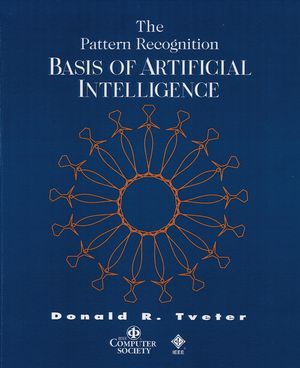The Pattern Recognition Basis of Artificial IntelligenceISBN: 978-0-8186-7796-0
Paperback
388 pages
March 1998, Wiley-IEEE Computer Society Press
 This is a Print-on-Demand title. It will be printed specifically to fill your order. Please allow an additional 10-15 days delivery time. The book is not returnable.
|
||||||
1 Artificial Intelligence.
1.1 Artificial Intelligence and Intelligence
1.1.1 Intelligence.
1.1.2 Thinking.
1.1.3 The Turing Test for Thinking.
1.1.4 The Chinese Room Argument.
1.1.5 Consciousness and Quantum Mechanics.
1.1.6 Dualism.
1.2 Association.
1.3 Neural Networking.
1.3.1 Artificial Neural Networks.
1.3.2 Biological Neural Networks.
1.4 Symbol Processing.
1.5 Heuristic Search.
1.6 The Problems with AI.
1.7 The New Proposals.
1.7.1 Real Numbers.
1.7.2 Picture Processing.
1.7.3 Memories.
1.7.4 Quantum Mechanics.
1.8 The Organization of the Book.
1.9 Exercises.
2 Pattern Recognition I.
2.1 A Simple Pattern Recognition Algorithm.
2.2 A Short Description of the Neocognitron.
2.2.1 Detecting Short Lines.
2.2.2 A Typical Neocognitron.
2.2.3 Training the Neocognitron.
2.2.4 Some Results.
2.3 Recognizing Words.
2.4 Expanding the Pattern Recognition Hierarchy.
2.4.1 Hearing.
2.4.2 Higher Levels.
2.4.3 The Hierarchy.
2.4.4 On the Hierarchy.
2.5 Additional Perspective.
2.5.1 Other Systems.
2.5.2 Realism.
2.5.3 Bigger Problems.
2.6 Exercises.
3 Pattern Recognition II.
3.1 Mathematics, Pattern Recognition, and the Linear Pattern Classifier.
3.1.1 The Linear Pattern Classifier.
3.1.2 ADALINEs and MADELINEs.
3.1.3 Perceptrons.
3.2 Separating Nonlinearly Separable Classes.
3.2.1 The Nearest Neighbor Algorithm.
3.2.2 Learning Vector Quantization Methods.
3.3 Hopfield Networks.
3.3.1 The Hopfield Network.
3.3.2 Storing Patterns.
3.3.3 The Boltzman Machine.
3.3.4 Pattern Recognition.
3.3.5 Harmony.
3.3.6 Comparison with Human Thinking.
3.4 Back-Propagation.
3.4.1 History.
3.4.2 The Network.
3.4.3 Computing the Weights.
3.4.4 Speeding Up Back-Propagation.
3.4.5 Dealing with Local Minima.
3.4.6 Using Back-Propagation to Train Hopfield/Boltzman Networks.
3.5 Pattern Recognition and Curve Fitting.
3.5.1 Pattern Recognition as Curve Fitting.
3.5.2 Approximating Real-Valued Functions.
3.5.3 Overfitting.
3.6 Associative Memory and Generalization.
3.6.1 Associative Memory.
3.6.2 Local and Distributed Representations.
3.6.3 Reasoning within a Network.
3.7 Applications of Back-Propagation.
3.7.1 Interpreting Sonar Returns.
3.7.2 Reading Text. 3.7.3 Speech Recognition.
3.7.4 Detecting Bombs.
3.7.5 Economic Analysis.
3.7.6 Learning to Drive.
3.7.7 DNA Analysis.
3.8 Additional Perspective.
3.9 Exercises.
4 Rule-Based Methods.
4.1 Introduction.
4.2 Some Elementary Prolog.
4.2.1 Stating Facts.
4.2.2 Syntax.
4.2.3 Asking Questions.
4.2.4 Rules.
4.2.5 Recursion.
4.2.6 List Processing.
4.2.7 Other Predicates.
4.3 Rules and Basic Rule Interpretation Methods.
4.3.1 A Small Rule-Based System.
4.3.2 Forward Chaining.
4.3.3 Backward Chaining.
4.4 Conflict Resolution.
4.5 More Sophisticated Rule Interpretation.
4.5.1 Dealing with Incomplete Data by Asking Questions.
4.5.2 Other Activation Functions.
4.5.3 Uncertain Input.
4.5.4 Extra Facilities for Rule Interpreters.
4.6 The Famous Expert Systems.
4.6.1 DENDRAL.
4.6.2 MYCIN.
4.6.3 PROSPECTOR.
4.6.4 ACE.
4.6.5 XCON.
4.7 Learning Rules in SOAR.
4.7.1 A Searching Example.
4.7.2 The Power Law of Practice.
4.8 Rules versus Networks.
4.9 Exercises.
5 Logic.
5.1 Standard Form and Clausal Form.
5.2 Basic Inference Rules.
5.2.1 Inference Rules.
5.2.2 Clauses with Variables.
5.3 Controlling Search.
5.3.1 The Problem with Blind Searching.
5.3.2 Proof by Contradiction.
5.3.3 The Set-of-Support Strategy.
5.3.4 Weighting.
5.3.5 Prolog's Strategy.
5.4 An Example Using Otter.
5.4.1 The Problem.
5.5 The Usefulness of Predicate Calculus.
5.6 Other Reasoning Methods.
5.7 Exercises.
6 Complex Architectures.
6.1 The Basic Human Architecture.
6.2 Flow of Control.
6.3 The Virtual Symbol Processing Machine Proposal.
6.4 Mental Representation and Computer Representation.
6.4.1 A Problem with Symbolic Representation.
6.4.2 Symbol Grounding as a Solution.
6.4.3 Structure and Operations on Structures.
6.5 Storing Sequential Events.
6.5.1 The Symbolic Solution.
6.5.2 Neural Solutions.
6.6 Structuring Individual Thoughts.
6.6.1 The Symbolic Methods.
6.6.2 Neural Methods.
6.7 Frames and Scripts.
6.7.1 Schemas and Frames.
6.7.2 Scripts.
6.8 Exercises.
7 Case-Based and Memory-Based Reasoning
7.1 Condensed versus Uncondensed Knowledge
7.1.1 Arguments For Condensed Knowledge
7.1.2 Arguments Against Condensed Knowledge.
7.1.3 Problems with Condensed Representations.
7.2 Memory-Based Reasoning.
7.2.1 A Simple Example.
7.2.2 MBRtalk.
7.2.3 A HERBIE Solution to Reading.
7.2.4 JOHNNY.
7.2.5 PACE.
7.3 Case-Based Reasoning.
7.3.1 Case-Based Reasoning in People.
7.3.2 CHEF.
7.4 Other Case-Based Programs.
7.5 Exercises.
8 Problem Solving and Heuristic Search.
8.1 The 8-Puzzle.
8.1.1 The Blind Search Methods.
8.1.2 Heuristic Searches.
8.1.3 Other Methods.
8.2 A Geometry Theorem Prover.
8.3 Symbolic Integration and Heuristic Search.
8.3.1 SAINT.
8.3.2 A Symbolic Program to Learn Integration.
8.3.3 A Partial Back-Propagation Solution.
8.4 Other Heuristic Programs.
8.5 Exercises.
9 Game Playing.
9.1 General Game Playing Techniques.
9.1.1 Minimax.
9.1.2 More Sophisticated Searching Methods.
9.1.3 Using Experience.
9.2 Checkers.
9.2.1 Rote Learning.
9.2.2 Generalization Learning.
9.2.3 Samuel's Later Work.
9.2.4 Chinook.
9.3 Backgammon.
9.3.1 Berliner's BKG Program.
9.3.2 Backgammon using Back-Propagation.
9.3.3 A Second Back-Propagation Approach.
9.3.4 Temporal Difference Learning.
9.4 Exercises.
10 Natural Language Processing.
10.1 Formal Languages.
10.2 The Transition Network Grammar.
10.2.1 A Simple Transition Network.
10.2.2 A Prolog Implementation.
10.2.3 A Neural Analog.
10.2.4 Syntax is not Enough.
10.3 Semantics-Based Methods.
10.3.1 Semantic Grammar.
10.3.2 Conceptual Dependency Notation.
10.4 Scripts and Short Stories.
10.5 A Neural-Network-Based Approach.
10.6 Defining Words by the Way they are Used.
10.7 A Recurrent Network for Sentences.
10.8 Neural-Based Scripts.
10.9 Learning the Past Tense of Verbs.
10.9.1 Over-Regularization.
10.9.2 The Rumelhart and McClelland Network.
10.9.3 The Classical Rule-Based Model.
10.9.4 A Hybrid Model.
10.10 Other Positions on Language.
10.11 Exercises Afterword.
A Appendix A.
A.1 A Derivation of Back-Propagation.
A.1.1 The Delta Rule.
A.1.2 The Generalized Delta Rule, or Back-Propagation.
Glossary.
Bibliography.
Index.



